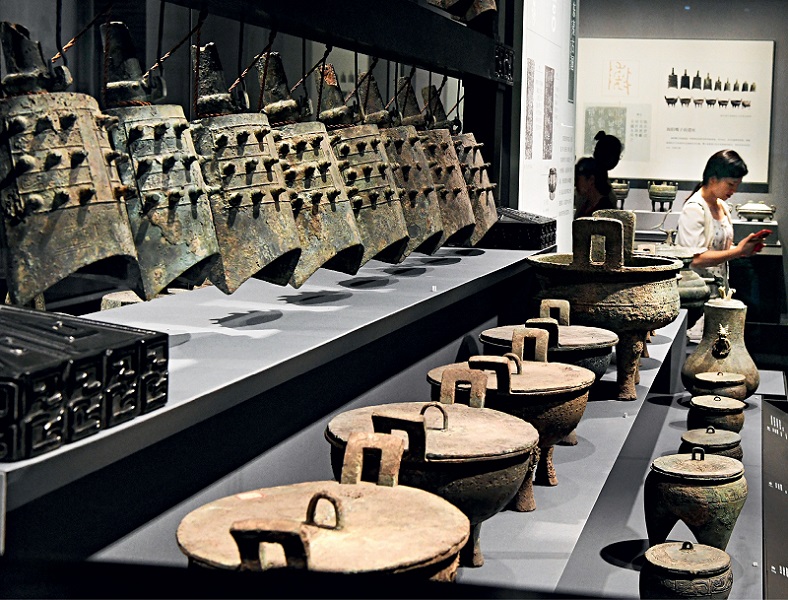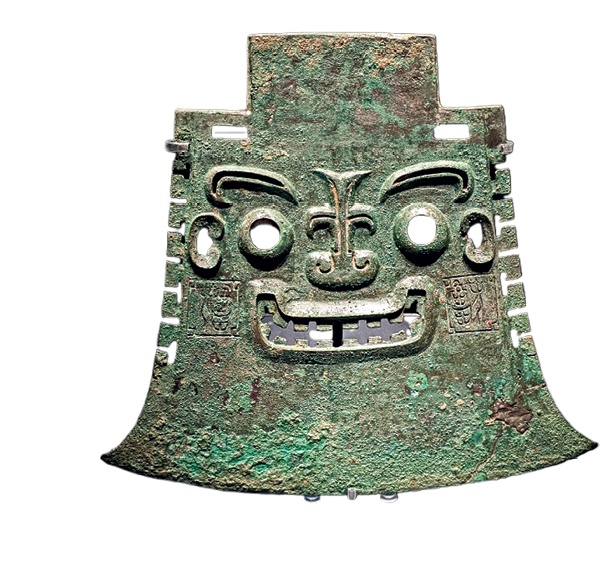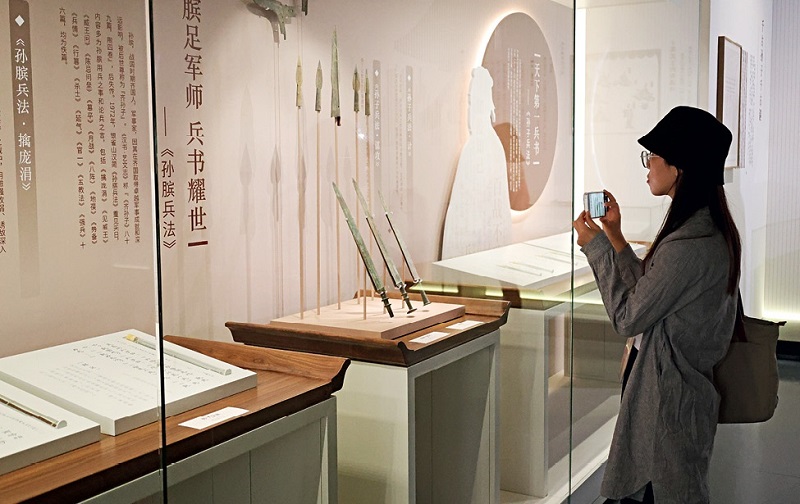A place where visitors can explore ancient Chinese military thought, dive into the sophisticated Zhou Dynasty rites, and enjoy fun culture-inspired activities.

A collection of bronze ware on display at the Shandong Museum on September 9, 2023.
Coastal Shandong Province, where the Yellow River joins the sea in eastern China, has always been the frontline of Chinese history. Archaeological evidence shows that as early as 600,000 years ago, ancient humans were already living there. It is here that the growth of Chinese civilization began – most notably, the State of Qi, one of the most powerful vassal states during the Spring and Autumn period (c.770-476 B.C.), and the State of Lu during the Zhou Dynasty (c.1046-256 B.C.), home to Confucius (551-479 B.C.) and a cradle of customs and rituals. Together, these two vassal states shaped the cultural identity of Shandong, which has since been known as the “Land of Qi and Lu.”
With an exhibition area of 25,000 square meters, the Shandong Museum houses over 400,000 cultural relics that bear testament to Shandong’s position in Chinese history. Among its most renowned treasures are the Nine-Tasseled Crown, the bamboo-slip manuscripts of two volumes of Art of War, and the bronze Yachou Yue (axe blade).

One of the most noted treasures of the Shandong Museum – Yachou Yue.
Sun Tzu’s Art of War
The State of Qi was known for its advanced strategic military thinking. In 1972, a collection of military treatises written on bamboo slips were unearthed from a Han tomb in Linyi, Shandong. The most notable of this find were scripts of Sun Tzu’s Art of War and Sun Bin’s Art of War, the latter having been lost for over 1,700 years. A combination of some 5,000 slips were eventually uncovered.
Sun Tzu’s Art of War was written by Sun Wu, a native of Qi in the Spring and Autumn period, which remains relevant today, represents the pinnacle of ancient Chinese military theory and established a tradition that values tactics and wisdom in warfare.
The roots of military strategy in Qi can be traced back to the early Western Zhou Dynasty (c.1046-771 B.C.), when Jiang Ziya, a revered founding minister, was enfeoffed in Qi and granted the right to fight against rebel states on behalf of the Zhou emperor. This military mission, coupled with frequent wars at the time, nurtured a flourishing military culture.
Despite the diversity of Qi’s military theories, two core principles remain the bedrock: War should have a moral purpose – fighting to end fighting; War should be regarded as the last resort and the least desirable means in resolving conflict. These visions reflect the nature of Qi military thought – an integration of wisdom, courage, strategy, and morality.

A centerpiece relic of the Shandong Museum – the Great Jade Bi.
Rites of Lu
A star exhibit at the museum, the Great Jade Bi (a flat jade disc with a circular hole in the center) of the State of Lu, showcases Lu as a “land of etiquette.”
Unearthed in Qufu, the seat of Lu’s capital, in 1977, this jade disc measures 32.8 cm in diameter with a hole of 11.6 cm in diameter, making it the largest jade bi (symbolizing the cyclical nature of life and the cosmos) found from the Warring States period (c.475-221 B.C.). Both sides of the disc bear identical dragon and grain motifs.
As its lords belonged to the clan of Zhou emperors, the State of Lu was known for its faithfulness to the Zhou ritual system since its founding. By the Spring and Autumn period, when rites elsewhere were breaking down, Lu became the hub for preserving them. This preservation fostered the rise of Confucianism, with Confucius himself – born in Zouyi (modern-day Qufu) – dedicating his life to promoting rites, benevolence, and virtues.
Nine-Tasseled Crown
Another masterpiece of ritual culture on view at the Shandong Museum is the Nine-Tasseled Crown of Zhu Tan, Prince of Lu from the Ming Dynasty (1368-1644) – the only complete ancient crown of its kind found to date. This ceremonial headpiece dating back to the Zhou Dynasty was worn during rituals of sacrifice to Heaven and Earth, and commemoration of ancestors, as well as on other formal occasions.
This invaluable treasure was excavated from the tomb of Zhu Tan, the 10th son of Ming Dynasty’s founding emperor Zhu Yuanzhang. Historical records state that Zhu Tan was smart, eager to learn, and humble as a child, making him a favorite son of the emperor.
Yet after being enfeoffed at the age of 15, he succumbed to extravagance and pleasure-seeking, and even indulged himself in immortality remedies. At 19, he died from poisoning after taking an excessive dose of “elixir of life”. Though deeply disappointed, Zhu Yuanzhang still gave his son a lavish burial, along with countless artifacts, including the Nine-Tasseled Crown.

A visitor views items surrounding Sun Bin's Art of War at a Han Dynasty bamboo slips exhibition at the Shandong Museum on April 25, 2025.
Yachou Axe-Blade
Dubbed the “meme artifact,” the Shang Dynasty bronze Yachou Yue (axe blade) went viral on social media in recent years with its quirky smile. Measuring 32.5 x 34.5 cm, its design is a comical grinning face featuring a pair of wide eyes and a mouth displaying neat, large teeth. Over 3,000 years ago, this charming piece was a ceremonial item. The inscription “Yachou” identifies its origin as the mysterious Yachou tribe.
Originally used as a weapon and execution instrument, the yue gradually evolved into a ritual object. Its exaggerated beast-face design meant to intimidate enemies. Discovered at a Shang Dynasty (c.1600-1046 B.C.) tomb in Qingzhou, Shandong in1965, this item offers crucial insights into the mysterious Yachou tribe that once thrived in the province.
Cultural Threads
Beyond its weekly free public lectures by experts, the Shandong Museum hosts special events on public holidays, festivals and special occasions. For example, on June 14, 2025 – China’s Cultural and Natural Heritage Day – it organized a series of activities. The Shandong embroidery workshop was a highlight of the event. The specific embroidery pattern taught at the workshop was inspired by the museum’s signature item: the Yachou Yue. Under the guidance of master embroiderers, participants learned basic stitching techniques and stitched meticulously, weaving the threads of centuries-old craftsmanship into the fabric of modern-era Shandong.